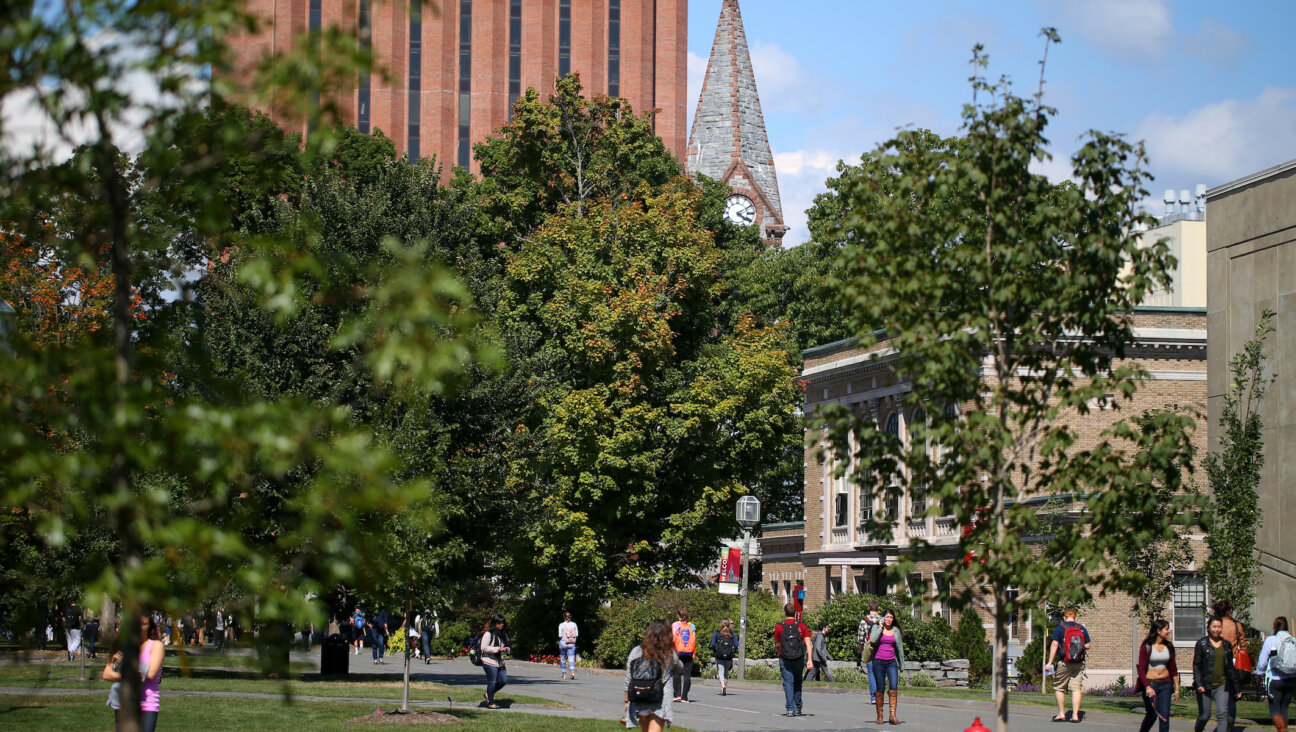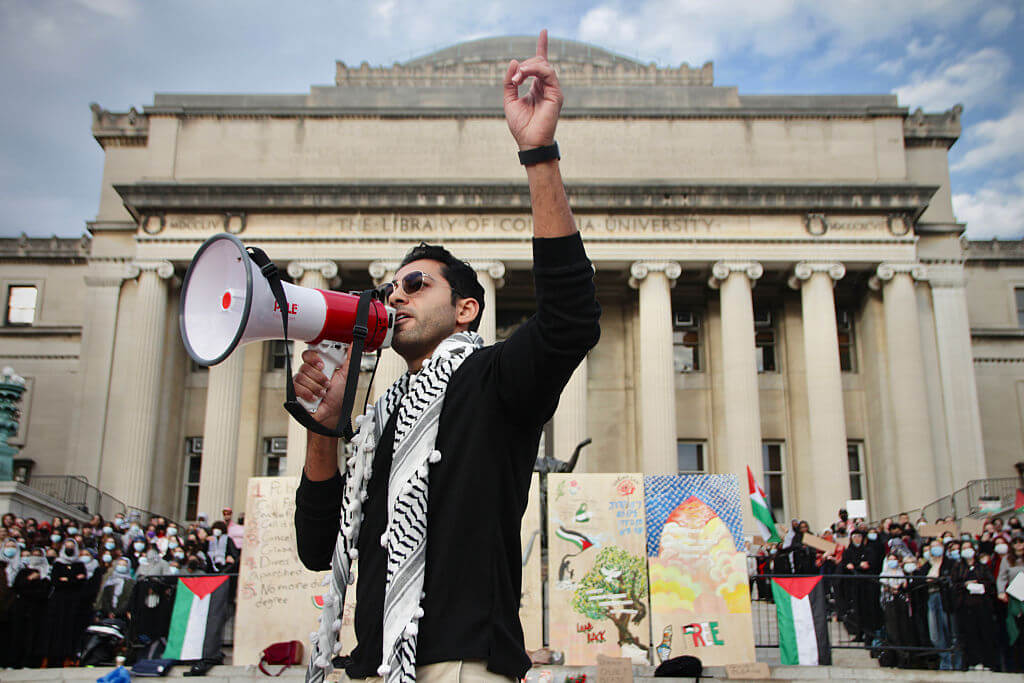Grave-Robbers Target Cuba’s Jewish Cemeteries in Search of Bones for Rituals

Occult Doings: Many of Cuba?s Jewish cemeteries have been deteriorating for decades. But some blame a new round of grave-robberies on occult rituals that require the bones of non-Christians. Image by ilan stavans
Guanabacoa, a colonial town southeast of Havana where the first African guild was created to alleviate the plight of slaves in Cuba, is a somewhat improbable home for not one, but two Jewish cemeteries, both of them more than a century old. They are not the only places where Jews are buried on the island, but their strategic location, half an hour by car from the capital, makes them the most prominent.
As I stopped there in April, during a trip that took me to different corners of Latin America, I was horrified by what I saw: A number of the tombs are in ruin, but not from natural decay. They have been desecrated.
The cemeteries sit next to each other. The largest, Centro Macabeo of Cuba, is used mostly for Ashkenazim. It was founded in 1906 and erected in 1910. Its frontispiece also reads “United Hebrew Congregation,” which points to the American funds with which it was built. The other graveyard is the Cementerio Sefardí, once serving the Sephardic community of Havana.

Image by ilan stavans
I have a passion — perhaps even an obsession — with cemeteries. I have visited Jewish ones countless times. Their state, I might say, is a mirror of the society surrounding them: When Jews thrive, their graveyards shine; when they are in distress, the tombstones are in disarray. In the cases of Guanabacoa’s two graveyards, the mess is, to a large extent, an expression of what the Jewish community there has gone through: exile, abandonment, forgetfulness.
At its height, Cuba had some 10,000 Jews. The island was a popular destination for American Jews. Meyer Lansky helped build a hotel on the Malecón, Havana’s gorgeous coastline. Castro’s revolution of 1958 to 1959 put a damper on Jewish life. People left in hordes, with a large constituency ultimately settling in Miami. America’s embargo has since kept numbers down. Depending on whom you ask, there are between 750 and 1,500 Cuban Jews in the nation today. A great many of them are converts or products of mixed marriages who identify as Jews.
In some ways, the sorry state of the two cemeteries could be viewed as a reflection of the abandonment and reduced circumstances that Havana’s remaining Jews have experienced during decades under Castro’s communist rule — at least until the 1990s, when the government lifted many of its restrictions on religious communities and allowed Cuba’s Jews to travel freely to Israel and permitted American Jews to visit them.
Yet this doesn’t begin to express the rage I felt at the desecration.
Even Ruth Behar, a Cuban-born anthropologist at the University of Michigan who visits Cuba regularly and who accompanied me on this trip, was stunned at the sight of these two graveyards. The tombs have been vandalized; the marble stones are broken to pieces, their fragments put back in place. Inside, bones have been stolen.
I asked Behar and my other companions from the Jewish community if the damage was something new. They told me it looked visibly worse now but the defacement wasn’t unheard of. Nor is it exclusive to Jewish cemeteries. For instance, they mentioned that some desecration has taken place at the Cementerio Colón, the main graveyard in Havana, located in the Vedado neighborhood and built in 1876. But the acts of vandalism there are minor. More cases occur in Chinese cemeteries. In any case, they agreed that the Jewish tombstones have suffered substantially in recent times.
I inquired into the cause and received three explanations:
The first is the popular suspicion that Jews bury their dead with jewelry. Castro’s revolution organized nationwide education programs that have paid off. The percentage of illiteracy is minuscule compared with other Latin American countries. Equally, state-run efforts to eliminate poverty, in cities as well as in the countryside, have been effective. Still, the country’s economy is in shambles. It once survived as part of its loyalty to the Soviet Union and is now dependant on Venezuelan oil and other products delivered by Venezuela out of political empathy. In other words, searching for treasures in tombs, especially in Jewish ones, isn’t accidental.
The second explanation is far less believable. Since Raul Castro took over the reign of the government from his ailing brother, Fidel, private enterprise has tentatively emerged on the island, with restaurants opening up, real estate being sold, the construction industry widening and so on. Marble is a commodity with market value. The challenge with this explanation is that, as far as I could assess, the tombstones, while broken, are not missing any marble.
The third explanation — and unquestionably the most worrisome — has to do with religious practices in Guanabacoa. In the 1920s, the town had several Jewish garment businesses, including Sedanita, owned by an American Jew from the Lower East Side. But the town is best known for Santería, a syncretic Caribbean belief that combines West African elements with Christian motifs. Less well known is another religion with African roots that took hold in Cuba; it’s called Regla de Palo Monte, or simply Palo Monte.
One of the rituals of Palo Monte requires the use of bones from nonbaptized people. These bones come from Jewish and Chinese graveyards. The Jewish bones are the only ones used to ward off the evil eye.
This last explanation left me stunned. I asked Behar if the Cuban government does anything to stop the practitioners of Palo Monte. She said they are part of a colonial-era religion with a growing number of adepts in the country, and the authorities are unlikely to undermine it since it plays a central role in the nation’s collective identity. But should that collective identity be built on dishonoring the dead of other faiths, in this case the Jews?
While my entire stay in Guanabacoa lasted no more than a couple of hours, I have dreamed of it repeatedly. The feeling I have is of disbelief, not to say disquiet. Tolerant as one should be of other people’s cultural practices, I cannot — will not — appease my indignation.
The dead are our past. Our foundation.
Ilan Stavans can be reached at [email protected]
The Forward is free to read, but it isn’t free to produce

I hope you appreciated this article. Before you go, I’d like to ask you to please support the Forward.
Now more than ever, American Jews need independent news they can trust, with reporting driven by truth, not ideology. We serve you, not any ideological agenda.
At a time when other newsrooms are closing or cutting back, the Forward has removed its paywall and invested additional resources to report on the ground from Israel and around the U.S. on the impact of the war, rising antisemitism and polarized discourse.
This is a great time to support independent Jewish journalism you rely on. Make a gift today!
— Rachel Fishman Feddersen, Publisher and CEO
Support our mission to tell the Jewish story fully and fairly.
Most Popular
- 1

Fast Forward Ye debuts ‘Heil Hitler’ music video that includes a sample of a Hitler speech
- 2

Opinion It looks like Israel totally underestimated Trump
- 3

Culture Cardinals are Catholic, not Jewish — so why do they all wear yarmulkes?
- 4

Fast Forward Student suspended for ‘F— the Jews’ video defends himself on antisemitic podcast
In Case You Missed It
-

Culture How one Jewish woman fought the Nazis — and helped found a new Italian republic
-

Opinion It looks like Israel totally underestimated Trump
-

Fast Forward Betar ‘almost exclusively triggered’ former student’s detention, judge says
-

Fast Forward ‘Honey, he’s had enough of you’: Trump’s Middle East moves increasingly appear to sideline Israel
-
Shop the Forward Store
100% of profits support our journalism
Republish This Story
Please read before republishing
We’re happy to make this story available to republish for free, unless it originated with JTA, Haaretz or another publication (as indicated on the article) and as long as you follow our guidelines.
You must comply with the following:
- Credit the Forward
- Retain our pixel
- Preserve our canonical link in Google search
- Add a noindex tag in Google search
See our full guidelines for more information, and this guide for detail about canonical URLs.
To republish, copy the HTML by clicking on the yellow button to the right; it includes our tracking pixel, all paragraph styles and hyperlinks, the author byline and credit to the Forward. It does not include images; to avoid copyright violations, you must add them manually, following our guidelines. Please email us at [email protected], subject line “republish,” with any questions or to let us know what stories you’re picking up.















